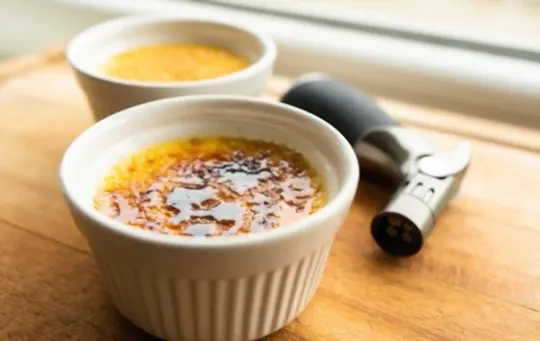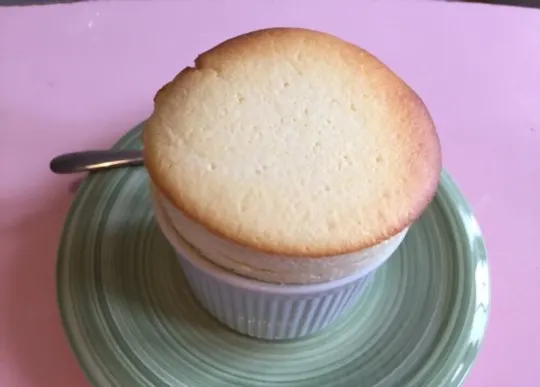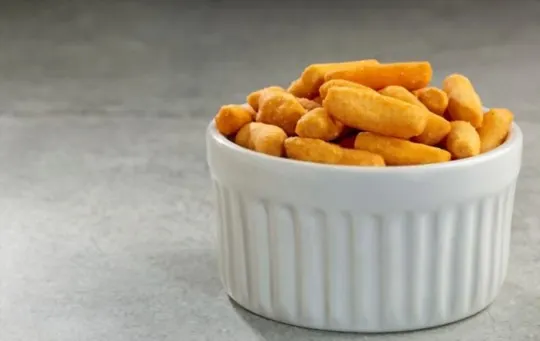In the kitchen, we all face the eternal debate: soufflé dish or ramekin? These aren’t twins, folks. Each has its own vibe going on.
We’ve been there, grabbing whatever’s clean to whip up that recipe we found online. Soufflé dishes are the deep-divers of our baking adventures, spacious and ready for those airy, ambitious soufflés we brag about to our friends.
Ramekins? The versatile buddies. Good for crème brûlée, holding our earrings, or a dollop of dipping sauce. They’re the smaller, mightier warriors in the face-off against the vastness of a soufflé dish.
Join us, and we’ll unearth the mysteries behind these kitchen staples.
What is a Soufflé Dish?

A soufflé dish is great for making soufflés, custards and casseroles.
It’s usually made from porcelain or ceramic and has high, straight sides to help the soufflé rise.
Soufflé dishes come in various sizes and shapes.
Some even feature fluted edges for a stylish touch.
This dish is not just for making soufflés – it can be used for other oven-baked dishes, too.
Unlike ramekins, soufflé dishes are larger and have higher sides to prevent the contents from spilling while baking.
The bigger size and thickness of the dish ensures heat is distributed evenly during cooking.
This gives you a perfectly cooked dish each time.
For a kitchen item with more uses than just making soufflés, get a quality soufflé dish.
What is a Ramekin?

Ramekins are handy vessels for preparing and serving individual portions.
They come in different materials like porcelain, ceramic, glass or metal.
Perfect for custards, soufflés, mac ‘n’ cheese, or even as dipping bowls.
Their small size makes them easy to store and handle and great for portion control.
Their straight sides and rounded bottom design helps with even cooking and good browning.
They can take high temperatures too, so they’re suitable for ovens and broilers.
Ramekins also come in handy when prepping food ingredients or measuring liquid ingredients.
Chefs and cooks, if you want to impress with your presentation, ramekins are the perfect way to make sure each guest gets a perfectly cooked meal.
Differences Between Soufflé Dish and Ramekin

Soufflé dishes and ramekins – they look similar, but have some differences.
Soufflé dishes are usually bigger and their sides are straighter – ideal for soufflés to rise evenly.
Ramekins have sloped sides and are for individual servings in different sizes.
Size and Shape
Soufflé dishes and ramekins are both kitchen must-haves.
But what sets them apart? Size and shape.
Soufflé dishes are bigger and have sloped edges and straight sides.
Ramekins, on the other hand, are more petite and have straight edges.
The size of soufflé dishes can vary – they come in round or oval shapes.
When making soufflés, the larger size of a soufflé dish lets it rise better.
Its edges give it support as it grows.
Ramekins are great for small recipes or individual servings.
Another factor to consider is the dish’s depth.
Soufflé dishes have greater depth than ramekins.
This makes them perfect for desserts like crème brûlée and custards that need longer baking times.
Which one should you use? It depends on what you’re making – ramekins for individual portions or dips.
Soufflé dishes for larger items like casseroles or soufflés.
Investing in a quality soufflé dish might be worth it.
Materials Used
When it comes to baking, there are many utensils.
Like soufflé dishes and ramekins.
They may seem alike but there’s a difference.
Soufflé dishes are bigger and wider than ramekins.
They are made for a mixture that rises when baking.
The batter needs space for expansion and soufflé dishes provide that.
Ramekins are smaller.
They have a flatter shape and are used for individual servings.
Not bigger dishes like soufflés.
Both can be useful in the kitchen.
If you need something with volume, try a soufflé dish.
For something smaller, a ramekin works great.
Creme brulee or flan are perfect.
Purpose and Culinary Uses
Do you cook fancy dishes? Soufflé dishes and ramekins may look the same, but they are different.
Soufflé dishes are larger and taller.
They help the dish keep its shape while baking.
Ramekins are smaller and shallower.
They are perfect for custards or pies.
Soufflé dishes have wider tops that make pouring ingredients easier.
They also have smooth surfaces which help the egg whites rise.
Ramekins come in round or oval shapes.
You can use these dishes interchangeably, depending on your preference.
But if a recipe calls for one, stick with it for the best results.
Understand the differences between soufflé dishes and ramekins to choose the right tool for your desired outcome.
With the right dish, your culinary creations will be amazing.
Similarities Between Soufflé Dish and Ramekin

Soufflé dishes and ramekins both have a critical role in the kitchen.
They look similar, yet differ slightly.
Both are small, cylindrical containers used for baking and serving individual portions of food.
Usually, they are made from materials such as ceramic or porcelain, with a glaze to prevent sticking.
They are both used to bake recipes like custards, soufflés, crème brûlée, mini quiches, and pot pies.
However, they are not interchangeable.
Soufflé dishes are usually larger than ramekins, with straight sides.
Ramekins on the other hand, have flared sides that slope outward.
Plus, they also have different creating methods.
Straight walls of a soufflé dish are wide enough for egg whites to stretch when whipped.
This creates meringue-like soft peaks that rise like an angel.
Meanwhile, sloping angles of ramekins ensure even heat distribution around its edges.
This results in cut-and-serve desserts like crème brûlée, with a hard layer of caramel coating every inch of its surface.
Yum.
Considerations for Choosing Between Soufflé Dish and Ramekin
Choosing between a soufflé dish and a ramekin requires pondering several key factors.
Firstly, size is important.
Soufflé dishes are larger to give room for the soufflé to rise while cooking.
Ramekins are smaller and better for individual portions.
Presentation is also a factor.
Soufflé dishes are available in various shapes – from round to oval or square – which adds elegance when serving.
Ramekins may have simpler shapes, but some have colorful or decorative designs that add flair.
Material of the dish matters too.
Soufflé dishes are usually ceramic or glass for even heat distribution.
Ramekins can be ceramic or metal, each with its own benefits for durability and heat-distribution.
Lastly, think about versatility.
While soufflé dishes are mainly for making soufflés, they can also be used for quiches or frittatas.
Ramekins can be used for crème brûlées or individual desserts.
Recipes and Dishes Best Suited for Each
Cooking? It’s essential to use the right dish.
Soufflé dishes and ramekins are two of the most easily confused.
Though they look alike, they have different roles.
Soufflé dishes are taller with sides that let the mix rise without spilling.
You can use them to make soufflés, mousses, custards and more – they’re available in various sizes.
Ramekins have shorter sides and a wider top.
They’re great for gelatin desserts, crème brûlée, pot pies, roasted vegetables – even single servings.
Both dishes have unique effects on recipes.
So, when cooking, it’s important to follow the recipe exactly.
Availability and Practicality
Soufflé dishes and ramekins are essential kitchen tools.
They add elegance to your presentation and are practical too.
Different sizes and shapes are available in stores.
Soufflé dishes are great for delicate recipes like soufflés, mousses and quiches.
Ramekins are perfect for mini desserts, dips and more.
Plus, they are dishwasher-safe.
These versatile items give your dishes a professional look with the added bonus of being practical.
Care and Maintenance of Soufflé Dishes and Ramekins
Soufflé dishes and ramekins are for baking, serving, and presenting various treats, starters, or entrees.
Looking after them properly extends their lifespan and keeps them useful.
Clean them properly after every use.
Handle with care to avoid cracking and chipping.
Handwash with warm soap and water instead of a dishwasher.
Don’t use abrasive cleaning agents or scrubbing pads.
Soufflé dishes are deeper than ramekins.
They are better for baking soufflés as they rise higher.
Ramekins can serve individual portions of pudding or baked eggs.
Check for cracks or chips in the soufflé dish and ramekin before using.
Any with cracks should not be used.
Store in a dry area where they won’t get bumped.
So, taking care of soufflé dishes and ramekins is important.
Cleaning, handling with care, and using correctly will make them last.
Conclusion
To tell a soufflé dish apart from a ramekin, it’s important to know their unique traits.
Though similar on the outside, there are distinctions between them.
Soufflé dishes have deeper and narrower forms, ideal for making soufflés rise in the oven.
Ramekins, on the other hand, have shallow bases and straight walls that are perfect for custards and crème brûlée.
It all comes down to the depth of the dishes.
Moreover, the materials used can change how they’re used.
Soufflé dishes usually have ceramic or porcelain that can take more heat than materials used for ramekins, such as glass or stoneware.

Leave a comment